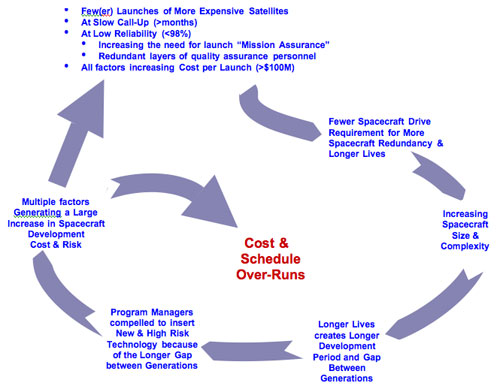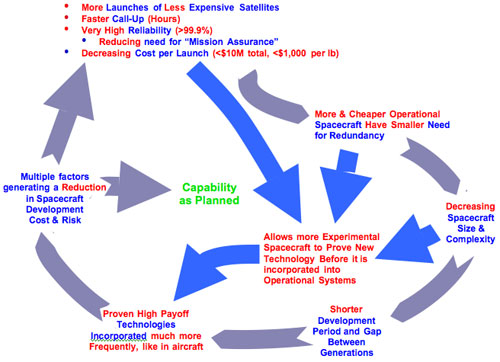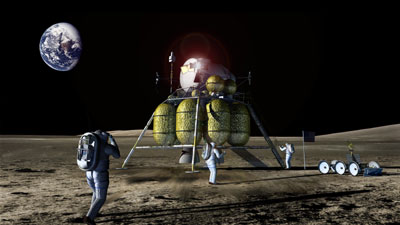The Vision for Space Exploration and the retirement of the Baby Boomers (part 2)Is this the beginning of the end, or the end of the beginning?by Charles E. Miller and Jeff Foust
|
| CRATS makes our entire national space agenda, including the VSE, both politically supportable and economically sustainable. |
CRATS is the key to incorporating the Solar System into our economic sphere. With CRATS, entire new industries become available. With CRATS, we will see commercial space stations succeed and grow. Bob Bigelow will now tell you what Walt Anderson would have told you seven years ago as the Mir station was being deorbited: cheap access to space is critical to closing the business case for a commercial space station. With CRATS we will see global point-to-point package delivery markets and an expansion of space adventure travel (or space tourism). With CRATS, we will see entire new ways of developing spacecraft, and new commercial markets for their services, and commercial satellite assembly, repair, and maintenance industries to support. With CRATS, which will also bring frequent, predictable access to space, we will see a significant increase in microgravity research, and perhaps entire new industries that none of us can predict. With CRATS, we may see space solar power become a reality in niche power markets that are considered to be small pieces of the multi-trillion-dollar energy industry, but are huge markets by space industry standards. With CRATS we will see entire new concepts that flourish, including on-orbit propellant delivery, propellant depots, reusable space tugs, orbital transfer vehicles, tethers, and in situ resource utilization. With CRATS, lots of little experiments with new technologies and concepts will suddenly be economically feasible, and we will see a renaissance in innovation and creativity and invention in space. With CRATS, and combined with the other new capabilities that will emerge because of the existence of CRATS, non-terrestrial resources will become economically feasible to use, and extremely valuable.
CRATS can also revolutionize space science. With launches much less expensive and more frequent than today, large spacecraft crammed with instruments—an approach designed to get the most out of expensive and infrequent launch opportunities—can be replaced with networks of smaller spacecraft. Such an approach, leveraging the great strides made in smallsats in recent years, allows missions that are not only less expensive, but also more redundant: a spacecraft failure results in the loss of a single instrument, not the entire mission. This approach could radically reshape studies of the Earth, Moon, Mars, and other destinations in the solar system. And even those missions that require larger monolithic spacecraft would still benefit from more reliable and less expensive launch services. This approach will allow the cost-effective development of scientific spacecraft far larger than we have today—creating instruments with apertures far larger than we see in the James Webb Space Telescope—after a commercial on-orbit assembly industry grows up around CRATS.
However much we all believe in this, it is difficult to sell national leaders this vision. We have both tried to sell this vision. It works for a few, but not for the vast majority, who care much more about bread and butter issues. The principal political value for the CRATS strategy is that CRATS delivers clear and specific benefits to national security. The national security benefits of the CRATS strategy are critical for political sustainability. It was national security that sold the transcontinental railroad. It was national security that sold the investments needed for the interstate highway system. It was national security that sold the Panama Canal. It was national security that drove federal investments in aeronautics research in the 20th Century. It was national security that sold Apollo. It is national security that is taking the lion’s share of today’s discretionary federal budget—for example, the war on terror and the war in Iraq was estimated by the Congressional Budget Office last year to cost up to $1.7 trillion through 2017; other estimates are even higher. Time and again, our elected leaders are willing to write big checks if you can convincingly link your initiative to national security.
Imagine the next Administrator of NASA going up to Capitol Hill and laying out how the Vision for Space Exploration will not only take us back to the Moon, to Mars, and beyond, that the VSE will not only bring the solar system into our economic sphere, but how the VSE will also help solve the following two national security problems. We assert that this is the most effective political argument that NASA could make, in any era, but particularly in an era of belt tightening.
One national security challenge CRATS would help solve
In January 2001, a bipartisan national commission, the Commission to Assess United States National Security Space Management and Organization, published a report that concluded that we are in danger of a “Space Pearl Harbor”.
In the executive summary of this report, the commission states:
The U.S. is an attractive candidate for a “Space Pearl Harbor.”
If the U.S. is to avoid a “Space Pearl Harbor” it needs to take seriously the possibility of an attack on U.S. space systems. The nation’s leaders must assure that the vulnerability of the United States is reduced and that the consequences of a surprise attack on U.S. space assets are limited in their effects.
History is replete with instances in which warning signs were ignored and change resisted until an external, “improbable” event forced resistant bureaucracies to take action. The question is whether the U.S. will be wise enough to act responsibly and soon enough to reduce U.S. space vulnerability. Or whether, as in the past, a disabling attack against the country and its people—a “Space Pearl Harbor”—will be the only event able to galvanize the nation and cause the U.S. Government to act.
We are on notice, but we have not noticed.
…
United States deterrence and defense capabilities depend critically on assured and timely access to space. The U.S. should continue to pursue revolutionary reusable launch vehicle technologies and systems even as the U.S. moves to the next generation of expendable launch vehicles.
Providing active and passive protection to assets that could be at risk during peacetime, crisis or conflict is increasingly urgent. ... reusable launch vehicles are needed to improve the survivability of satellites on orbit as well as the ability to rapidly replace systems that have malfunctioned, been disabled or been destroyed.
The threat of a Pearl Harbor in space has only gotten worse since the National Commission’s report was published:
| By its very existence, CRATS will eliminate most of the benefit of a surprise attack on our satellites, and therefore would probably never need to be used in a major war. |
1. Our military continues to reduce its stockpiles of cheap, dumb bombs. We are now even more dependent upon space assets to effectively conduct war. If a “near-peer” takes out our orbital assets with an asymmetric strike, we will be “dumb”, “deaf”, and “blind”. For example, if they take out our GPS satellite capability (which can be done in many ways), our smart bombs will be dumb bombs. And we will have much less of them than we had in even the first Gulf War.
2. Al Qaeda and other parts of the Iraqi resistance have publicly proven the effectiveness of asymmetric warfare against the US. Therefore, we should expect that asymmetric attacks will be the strategy of choice for the foreseeable future against the US.
3. In January 2007, China demonstrated that they are developing the capability to produce this “Space Pearl Harbor” by destroying a satellite in orbit. This now proven Chinese capability utilizes a mobile launcher, which means it is almost impossible for the US to target.
4. In 2006, North Korea demonstrated both a nuclear device and ballistic missiles, which in combination can be used for a high-altitude nuclear detonation. This kind of “asymmetric” attack could destroy many commercial and national security satellites in Earth orbit, producing tremendous damage to our economy, and leave us extremely vulnerable to national security threats from all other actors for years to come. North Korea is perhaps one of the most unpredictable governments on the planet.
5. Iran is also developing both ballistic missiles and nuclear technology.
6. Evidence was recently disclosed suggesting the Syrian site that was bombed by Israel in 2007 was a nuclear weapons development site, which appeared to be a near identical copy of a North Korean nuclear site.
7. The Iran, North Korea, and Syria Nonproliferation Act (INKSNA) was specifically enacted into law to help deal with some of these threats. However, INKSNA can only slow down the core problem. It can’t solve it.
CRATS is a dual-use stabilizing deterrent to war
If China, North Korea, Iran, or another enemy were to destroy our assets in orbit, CRATS can rapidly replenish the satellites, and augment the capabilities that satellites provide. By its very existence, CRATS will eliminate most of the benefit of a surprise attack on our satellites, and therefore would probably never need to be used in a major war. In other words, CRATS is a stabilizing deterrent to a space war because it eliminates much of the incentive to attack our satellites in orbit in the first place.
During peacetime, CRATS would be put to productive use in many transformational commercial and civil government applications. CRATS would generate significant economic growth in the form of large numbers of high-paying commercial jobs, whole new industries, and many new technologies and innovations. CRATS is a transformational dual-use technology that will enable new American commercial industries of tens-to-hundreds-of-billions of dollars per year.
A second national security challenge CRATS would help solve
CRATS would also solve another major problem that has been creating headaches for the Department of Defense for the last two decades. The cost of DoD space programs is out of control. Again and again, major national security satellite programs — in both the US Air Force and the National Reconnaissance Office (NRO) are over budget, and take years longer than promised. The list of major cost overruns includes Space-Based Infrared Systems (High and Low), Advanced Extremely High Frequency communications satellites, Future Imaging Architecture, and the National Polar-orbiting Operational Environmental Satellite System, among others. As a result, Congress has lost confidence, and demanded action, and today’s US Air Force leadership is making another attempt to solve the problem, which they call “Back to Basics.”
There are no easy solutions. DoD space systems are in a vicious cycle of continuously higher costs. The DoD knows this is happening, yet it is extremely difficult to get out of this cycle. . The problem is systemic, as illustrated in Figure 1.
 Figure 1: Space systems are in a vicious cycle of continuously higher costs |
CRATS will solve this problem. When this nation acquires cheap and reliable access to space, the systematic influences and factors will be stood on their head, and we will get a virtuous circle as shown in Figure 2 below.
 Figure 2: Vicious cycle can be transformed to a virtuous cycle by cheap and reliable access to space (CRATS) |
CRATS has strong latent political support
There is political support, in both parties, for the objective of CRATS. The Clinton Administration (with some support by Al Gore and by Dan Goldin), and a Republican Congress with leaders such as Newt Gingrich, Bob Walker, and Dana Rohrabacher, eventually made CRATS a high priority in the 1990s. Unfortunately, the effort to achieve CRATS failed (more on that in part 3).
The last real focus on CRATS at the national level was October 11, 2001, when the House of Representatives held a hearing on “Spaceplanes and X-Vehicles”. We focus on this, as this hearing summarizes most of the key benefits of CRATS.
The congressional hearing charter summarized the benefits of spaceplanes as follows:
Development of a spaceplane technology that provided affordable space access and in-space maneuverability could benefit the commercial and civil sectors in ways that were unimaginable a decade ago. The ability to service satellites while in space may fundamentally change how satellites are designed and manufactured. On-orbit satellite servicing may permit streamlining of manufacturing processes ... Other space services made possible ... include retrieval of satellites from their operating orbit, rapid passenger and package delivery services to many points on the globe, and tourism.
Military Applications of Space Plane Technology
DoD has recently begun exploring space capabilities that can contribute to the transformation of the roles and function of the U.S. military in the 21st Century ... For example, the means to launch ‘operationally useful satellites’ on demand affords the military greater flexibility in areas like space surveillance, satellite repositioning, and power projection. The ability to perform in-space transportation would enable the U.S. to gain the strategic high ground and protect vital space assets, remove the threat posed by orbital space desbris, make changes in satellite position at will. Additionally, spaceplanes have the potential to perform on-demand reconnaissance, fly over any location from the contenental United States, maximize data collection, and complement air expeditionary forces by providing a rapid response to threats worldwide.
For many smart people, both inside and outside the US government, our arguments for CRATS may be common sense. The primary issue for many of them is not whether CRATS is a good thing—they agree it is—but the fact that we have now tried several times, that we have failed just as many times, and achieving CRATS is not an easy thing to do. In fact, when they hear arguments for CRATS, they almost automatically hear another call for huge multi-billion-dollar programs, which will probably fail again.
| The primary issue for many people is not whether CRATS is a good thing—they agree it is—but the fact that we have now tried several times, that we have failed just as many times, and achieving CRATS is not an easy thing to do. |
Any new initiative to achieve CRATS must address the repeated national failures (Shuttle, NASP, X-33, X-34) to achieve CRATS. Instead of trying the same old thing over again, and expecting different results, a new initiative would address the core reasons for the failure, and provide some ideas on a new approach.
So what should our nation do to achieve CRATS?
Stay tuned for Part 3 where we will demonstrate that neither a pure “programmatic mindset”, nor a pure “laissez-faire mindset” is to be recommended. We will make some specific recommendations for public-private approaches, which have historically succeeded in similar situations. And we will propose a paradigm—a mindset if you will—from which to think about this challenge and to organize the efforts of the best and brightest in our nation.
